Below Knee Amputation
iWALKCrutch sets the new standard for mobility devices
The below knee amputee community is raving about the benefits the iWALKCrutch has for below knee amputees. Whether you’re pre-amputation, post-amputation, or already using your permanent prosthetic, iWALKCrutch is a game changing temporary lower leg prosthetic that many BKAs use daily.
The iWALK crutch was designed for typical lower leg injuries such as Achilles ruptures, broken ankles, etc. Typical usage time is 3-10 weeks. The iWALK crutch was not intended for long term or permanent use, but it is quite durable, especially when you consider its light weight. The best advice we can give is to consider your iWALK to be similar to an athletic shoe – very durable, but will not last forever. How long it lasts depends largely on the frequency and conditions of use. It should be replaced at the end of its useful life.
Who Can Use the iWALK Crutch?
Aside from the standard requirements for establishing if you can use the iWALK Crutch, below-knee amputees also need to have a minimum of 4” (10cm) of residual limb. You also need to be able to tolerate weight on that shin. There may be other complications, but in our experience, most BKA’s adapt easily to the iWALK Crutch.
Unfortunately, above-knee amputees cannot use the iWALK Crutch without a prosthetic assistive device.
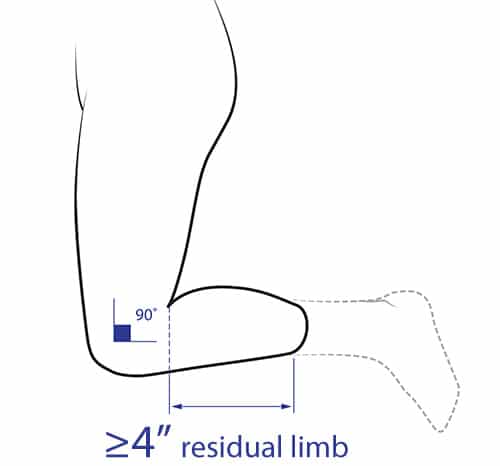
iWALK Crutch Before Amputation
iWALK Crutch Before Amputation. Whether you’ve suffered a traumatic life-changing injury or have been dealing with excruciating pain requiring foot amputation surgery, the iWALK Crutch is a game changer!
Contemplating an imminent below-knee amputation is traumatic. Concerns of loss of mobility, day-to-day lifestyle changes, loss of mobility, atrophy, and depression are well-founded and haunt most pre-amputees. These concerns have been drastically reduced thanks to the iWALK Crutch. Unlike with crutches or a wheelchair, using an iWALK Crutch pre-amputation demonstrates that a fully functional, independent lifestyle will be available after you’ve lost your limb, thus alleviating these concerns.
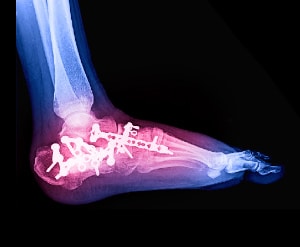
Use iWALK Crutch Before BKA Surgery
When preparing for a below knee amputation surgery, the iWALK Crutch can significantly improve the way you view your amputation. Unlike other mobility devices, the iWALK Crutch allows you to continue to function in your day to day activities, which is a huge reassurance just when you need it most. Here are a few more reasons below knee amputation surgery candidates are using the iWALK Crutch before their surgery:
Get Off Those Crutches (or Scooters) and Get Your Life Back
Most people contemplating amputation are already in significant pain and have difficulty using the affected limb. This often requires extended use of crutches, knee scooters or other mobility devices. Life on crutches or a knee scooter is severely limiting – the most common things become excruciatingly difficult. This comes at a most inopportune time when you contemplate the psyche of the pre-amputee – is this what life will be like after the amputation?
Using iWALK Crutch instead of these lesser devices keeps the pre-amputee non-weight bearing, but in addition, it also allows you to maintain a fully functional, pain free lifestyle. It shows you that you can and will function well after a below knee amputation.
It’s a Mobility Training Wheel
Imagine if there was a way to practice walking on a prosthetic before your amputation. Now there is! Technically speaking, the iWALK Crutch is an exo-skeletal temporary lower leg prosthetic, so using it before your surgery is going to help teach you how to walk with a prosthetic lower leg.
Prepare for Life After Amputation
There’s no way around it – after your amputation, you’re going to be immobilized for an extended period. Typically you’ll transition from bed to wheelchair, to crutches. During this time your leg will experience muscle atrophy at the rate of 1 ½ to 2 percent per day! So you must take advantage of your pre-amputation opportunities to exercise and condition your affected limb. But how do you exercise a leg that causes pain with every step? By using the iWALK Crutch you can keep weight off your injured lower limb and continue to exercise the remainder of your leg. Problem solved. Going into your amputation well-conditioned will make your transition infinitely easier.
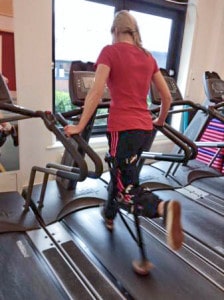
Independence Soon After Surgery
Knowing that you can use the iWALK Crutch soon after your surgery gives you solace that you can go back to your day-to-day activities right away. It’s hands-free, so you can get yourself a cup of coffee, carry groceries, even go to the grocery store. No crutches, no wheelchair, no prosthesis? No problem! In a few seconds, you can strap on the iWALK Crutch and get moving again.
A Positive Change in Overall Outlook and Attitude!
Knowing you are going to lose a foot is a tough thing to get used to. Knowing that you can get up and moving only a few weeks after surgery will help you get used to that idea. One below knee amputee stated, “The iWALK changed my outlook on life. It was so much better.” Below the knee amputee users have stated that frustration, anger, and depression both before and after amputation surgery was greatly reduced once they used the iWALK Crutch.
iWALK Crutch Post-Amputation
While the iWALK is a great tool to use before you have below knee amputation, users have found equally positive effects by using the iWALK Crutch immediately following foot amputation surgery.
Transitioning to a Prosthetic Can Take Months. Why Wait for Mobility?
After below knee amputation surgery, your body has to get used to its residual limb. Prosthetics can’t be fitted well or worn until swelling has subsided, incisions have healed, and swelling of your residual limb has fully subsided. This can take months. How are you supposed to live a functional lifestyle during this period?
The iWALK Crutch gets you moving almost immediately after surgery. Depending on the type of closure, some patients are using their iWALK Crutch in less than two weeks after their surgery.
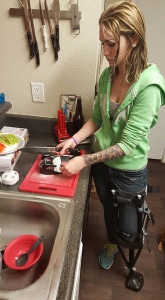
Mobility Leads to a Positive Outlook
Below knee amputees state that using the iWALK Crutch immediately after surgery helps “fix the psychological issues associated with below knee amputation.” You’re no longer bedridden, confined to a wheelchair, crawling, or messing around with crutches. The iWALK Crutch restores mobility and helps you maintain a positive psychological outlook, which is critically important at this delicate time.
The iWALK Crutch gets you moving almost immediately after surgery. Depending on the type of closure, some patients are using their iWALK Crutch in less than two weeks after their surgery.
Maintain Muscle Strength
One of the biggest issues with post operative below knee amputations is muscle atrophy. If inactive, the average person’s muscles atrophy 1.5 to 2% per day! This is especially significant for below knee amputees, because eventually you will begin the process of adapting to a permanent prosthetic. This is hard enough, but when you factor in the effects of significant muscle loss, a difficult task becomes even more so. By using the iWALK Crutch post-amputation / pre-prosthetic you can maintain your muscle mass and be well conditioned and ready when the time comes to transition to a permanent prosthetic.
Adapting to a Permanent Prosthetic? You’re Going to Need a Backup!
Prosthetics must be fitted and refitted. Your residual limb will shrink considerably in your first year, so your socket will constantly be fitted, refitted and replaced. It will take considerable time before you can tolerate your permanent prosthetic for extended periods during this adaptation phase, which means you’ll be back on crutches, often. What a tease! But if have an iWALK Crutch, you will continue to enjoy hands free mobility AND continue to train your body to walk on a prosthetic leg. iWALK Crutch is a potent backup prosthetic and essential during this period.
Maintain Muscle Memory and Get Ready for Your Prosthetic
Post-surgery iWALK Crutch users have found that by using the iWALK Crutch they maintain muscle and joint memory for walking, and they are able to keep their body in shape, enabling them to use the prosthesis with much less training.
iWALK Crutch Post Amputation Summary
iWALK Crutch is a game changer when it comes to transitioning from amputation surgery to full proficiency on a permanent prosthetic. Before iWALk Crutch, the amputee could not walk for months, and was forced to learn to use a prosthetic when their leg was considerably weakened and their muscle memory had faded. With iWALK Crutch you maintain conditioning, muscle mass, and practice using a prosthetic ‘training wheel’ for the entire period leading up to permanent prosthetic use.
In reference to his patient Steve, a transitional iWALK user, Mark Miller, CPO, stated, “In my 27 years’ experience of fitting amputees, I have never seen a transtibial amputee do so well so quickly with their prosthesis.” See more of Steve’s story in our amputee testimonials.
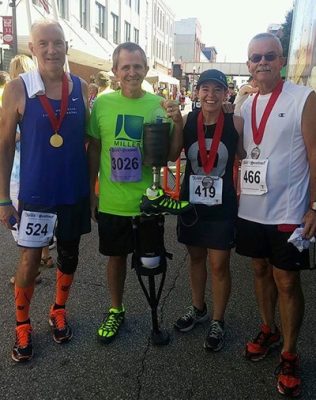
What about Contracture?
One of the primary issues faced by post-surgical below knee amputees is contracture. Contracture is the tightening of the soft tissue in the leg and can limit motion in the joint. It results in the inability to straighten the knee, and the hip may also become stiff.
Not a single below knee amputee that has shared their iWALK Crutch story has complained of contracture as a result of using the device. All of them have stated that, while they have used the iWALK Crutch, they have maintained a consistent stretching routine, as prescribed by their doctor.
iWALK Crutch is Your Go-To Prosthetic Alternative
You already have a prosthetic? You still need the iWALK crutch.
The iWALK Crutch isn’t just a transitional device for recovering below knee amputees. It is just as or even more useful as a back up to your permanent prosthetic.
The iWALK Crutch can be used anytime you don’t want to hassle with your prosthetic. Here’s what you need to know about the iWALK Crutch
Hands-free mobility
The iWALK Crutch is the only device that enables you to be hands-free. You can walk in comfort and with stability. No more worrying about stairs and lack of space with a wheelchair and the instability of crutches!
It’s a cinch to put on and take off – some say less than 5 seconds
Many iWALK Crutch below knee amputees use their iWALK to go to the bathroom in the middle of the night. No more crawling!
In addition, after a long day of wearing your prosthetic, you are ready to take it off. Before iWALK Crutch amputees tended to hop, crawl, or crutch around their house after removing their prosthetic for the day. iWALK Crutch enables below knee amputees to easily walk around the house without worrying about putting their prosthetic back on.
One BKA explained, “With the iWALK it only took a few seconds to be back to normal.”
Your Backup Device
Sometimes you just can’t use your permanent prosthetic. Soreness in your residual limb, skin irritation, bruises and wounds can make wearing your permanent prosthetic too painful. Repairs and adjustment require you leaving your prosthetic in the shop for days. So how are you supposed to survive these periods? No problem – your iWALK Crutch is your backup prosthetic allowing you to maintain your functional lifestyle.
One size fits all!
The iWALK is adjustable! Upper leg straps can be tightened or loosened depending on the width of your upper thigh. The lower leg straps are adjustable and can be fitted to your residual leg length. Click here for a tutorial video.

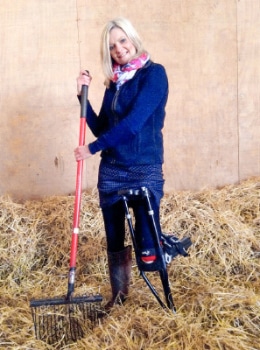
If your case is unusual, your prosthestist can make simple accommodations such as additional padding, thermoformed padding, etc. to custom tailor the iWALK Crutch for rare cases.
Donning and doffing is faster for amputees than non-amputees, because without a foot, you can instantaneously slip right into the straps without unbuckling.
It’s easy to clean
Gardening, going to the beach, mucking horse stalls (yes, it’s been done)? No problem! The iWALK Crutch is easy to clean. You can simply hose it off and let it dry. Many BKA’s use their iWALK Crutch in situations where they don’t want to damage their expensive, permanent prosthetic.
Shower while standing
Tired of sitting in the shower? Is your shower too small for a shower chair? The iWALK Crutch is the prefect alternative. Some below knee amputees have a designated iWALK Crutch just for the shower! As with any slippery surface, caution should be exercised when using iWALK Crutch while showering.
Suffering pain from the prosthetic?
Some below knee amputees say that eventually their leg tires of the prosthetic. The iWALK Crutch places pressure on different areas of the leg, so it gives those tired muscles and joints a break.
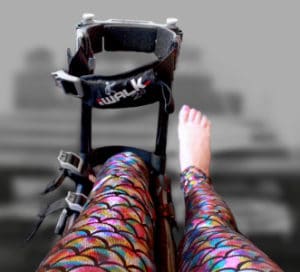
Just need a break?
Don’t want to hassle with your sleeve and prosthetic or just want to give your skin a break? The iWALK Crutch is the perfect alternative. And it’s hands-free, so you’re able to move about unencumbered.
Contracture
One of the primary issues faced by post-surgical below knee amputees is contracture. Contracture is the tightening of the soft tissue in the leg and can limit motion in the joint. It results in the inability to straighten the knee, and the hip may also become stiff.
Not a single below knee amputee that has shared their iWALK Crutch story has complained of contracture as a result of using the device. All of them have stated that, while they have used the iWALK Crutch, they have maintained a consistent stretching routine, as prescribed by their doctor.
Modifying the iWALK Crutch for BKA
Many BKA’s like to modify their iWALK Crutch by shortening the Knee Platform so that it is only slightly longer than their residual limb. If you want to make this modification, make sure you do it right!
Modifying iWALK3.0 Knee Platform
- Determine the correct length by wearing the iWALK as normal and marking a point that is behind the distal end of your residual limb.
- Take a measurement from the end of the platform to this mark.
- On the underside of the Knee Platform, use the measurement to determine where you will cut off the end of the Platform. You will make your cut BEHIND the nearest transverse rib that is BEHIND your measurement point. The diagram below shows you the four possible cut locations.
- Before you start cutting, you will want to trim the Platform Pad to length. On the underside of the Platform, measure the distance from where you will make your cut to the back of the platform. Transfer this measurement to the top of the Platform, and, using a box knife or other sharp cutting tool, make a transverse cut (from side to side) through the pad. Peel off any pad that is behind the cut.
- Cut off the end of the platform. Reminder – your cut should be directly BEHIND one of the transverse ribs.
- Using a file, grinder, sanding block or other abrasive tool, remove all sharp edges from the back of the Knee Platform.
- Near the end of the shortened Platform, drill a small hole in the center of the Strap Mount rail. Screw a small wood screw or sheet metal screw into the hole. This will prevent the Strap Mount from sliding off the back of the Knee Platform.
In the diagram below, the red lines show the four locations where you can cut the Knee Platform. Insert sheet metal or wood screws where indicated in green.
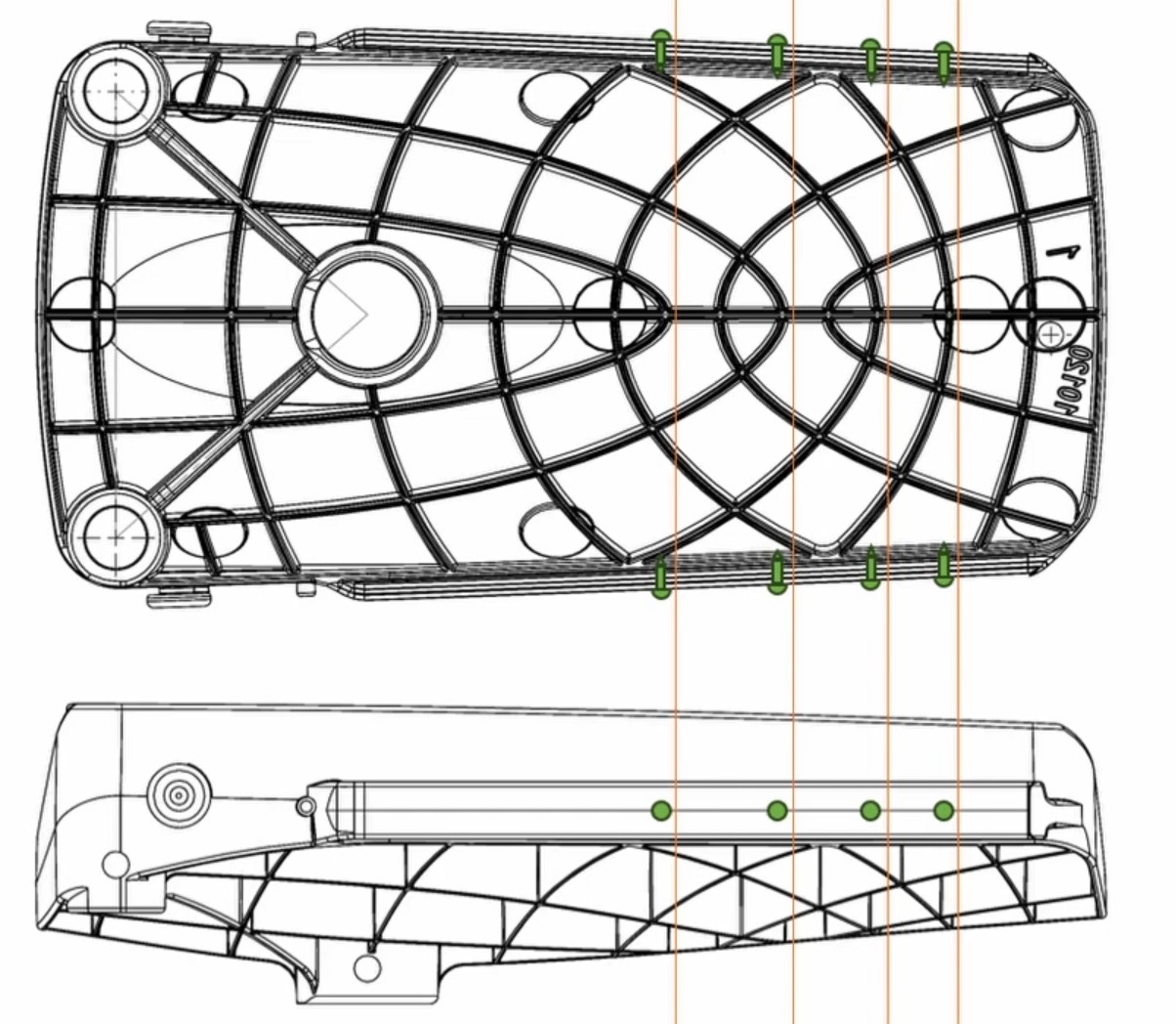
Discontinued Model
Youtber Jordan Beckworth shows the steps to modify your iWALK2.0 in the clip below. Follow the instructions and feel free to contact us if you have any questions.
- Determine the correct length by wearing the iWALK as normal and marking a point that is behind the distal end of your residual limb.
- Take a measurement from the end of the platform to this mark.
- On the underside of the Knee Platform, use the measurement to determine where you will cut off the end of the Platform. You will make your cut BEHIND the nearest transverse rib that is BEHIND your measurement point. The diagram below shows you the four possible cut locations.
- Before you start cutting, you will want to trim the Platform Pad to length. On the underside of the Platform, measure the distance from where you will make your cut to the back of the platform. Transfer this measurement to the top of the Platform, and, using a box knife or other sharp cutting tool, make a transverse cut (from side to side) through the pad. Peel off any pad that is behind the cut.
- Cut off the end of the platform. Reminder – your cut should be directly BEHIND one of the transverse ribs.
- Using a file, grinder, sanding block or other abrasive tool, remove all sharp edges from the back of the Knee Platform.
- Near the end of the shortened Platform, drill a small hole in the center of the Strap Mount rail. Screw a small wood screw or sheet metal screw into the hole. This will prevent the Strap Mount from sliding off the back of the Knee Platform.
In the diagram below, the red lines show the four locations where you can cut the Knee Platform. Insert sheet metal or wood screws where indicated in green.
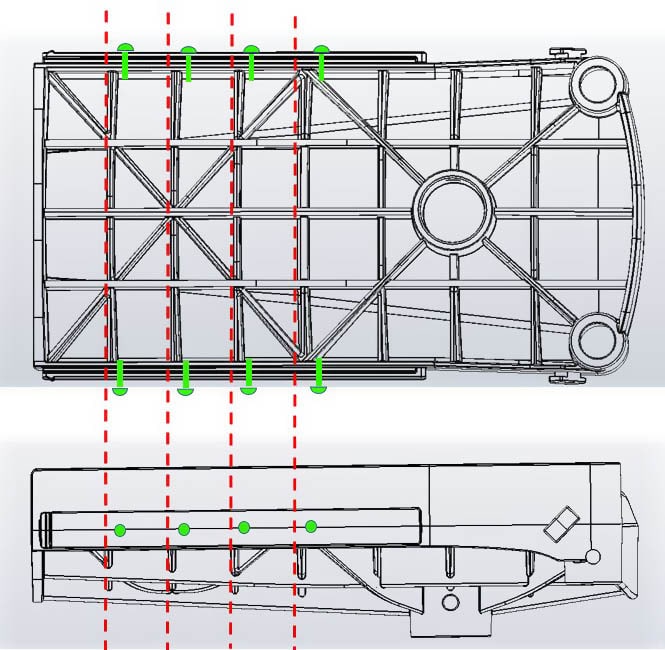
The iWALK crutch will change your life!
The iWALK Crutch makes a significant, positive difference in the everyday life of the below knee amputee. It’s a game changer that no BKA should be without.
Share your own iWALK experience with us
We love getting testimonials from our customers and often share them on our website, social media and other communications. Help us show others what the iWALK can do for them!

